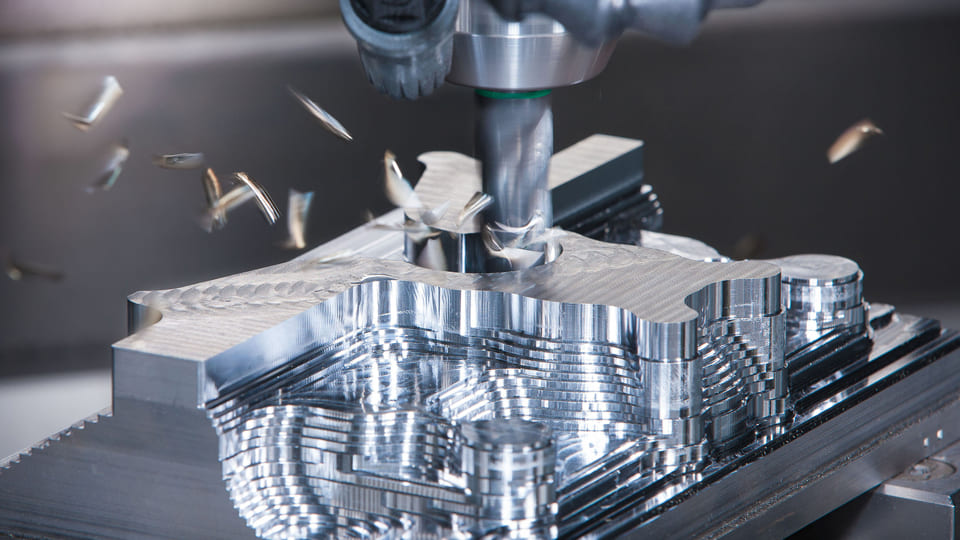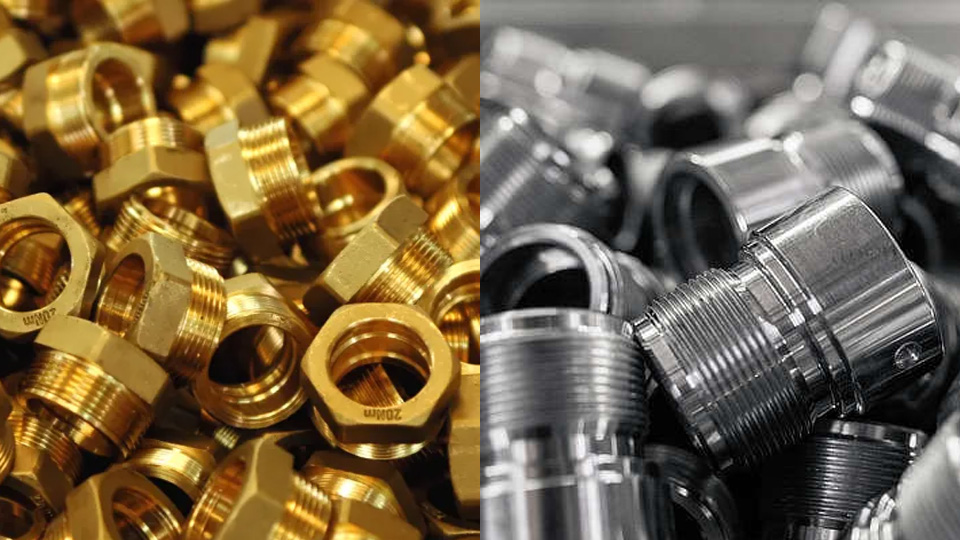The aerospace industry has long been a frontier of innovation, where precision, performance, and safety are paramount. With a vast market volume that encompasses commercial aviation, military aircraft, spacecraft, and satellite technology. A report from Reportlinker indicates that the global aerospace market is expected to grow from $247.61 billion in 2021 to $271.76 billion in 2022 at a compound annual growth rate (CAGR) of 9.8%.
Aerospace CNC machining is distinctive, driven by the unique characteristics of the aerospace industry. It’s a realm where the margin for error is minimal, where lightweight yet robust materials are a necessity, and where the quest for precision and performance is unrelenting. In this essay, we will delve into the vital role that CNC machining plays in aerospace, exploring its technologies, benefits, applications, and the impact it has on the aerospace industry.
What is Aerospace CNC Machining?
Aerospace CNC machining is a highly specialized manufacturing process employed in the aerospace industry to create intricate, mission-critical components for aircraft, spacecraft, and related systems. This process relies on Computer Numerical Control (CNC) technology, which allows for computerized control of machining tools, ensuring unparalleled precision and accuracy.
Aerospace components are subject to extremely tight tolerances, often measured in micrometers (microns) or thousandths of an inch. These exacting tolerances are critical for the reliable and safe operation of aerospace systems.
Process of Aerospace CNC Machining
There are various CNC machine types, but for high precision, the aerospace industry employs two major CNC machine operations:
CNC Milling
With its capability to create intricate shapes and features, CNC Milling plays a pivotal role in crafting essential components such as engine parts, turbine blades, and structural elements of aircraft and spacecraft. Multi-axis CNC milling, especially 5-axis CNC milling, takes precision to the next level. These machines can manipulate workpieces from 5 angles simultaneously, allowing for the production of complex geometries that are integral to aerospace systems and ensuring part accuracy and precision. Furthermore, CNC milling’s compatibility with a variety of aerospace materials, including metals and composites, provides the flexibility to select the best material for each application, contributing to weight-efficient design and fuel efficiency.

CNC Turning
CNC turning plays a fundamental role in achieving high precision and enhancing the safety and efficiency of aerospace systems. particularly for rotational components like engine shafts, fasteners, and bearings. This process achieves the rotational symmetry and precision that is crucial for the smooth operation of aircraft and spacecraft systems. It offers efficiency and flexibility, with minimal setup requirements, making it ideal for producing a diverse range of rotational parts.

Benefits of CNC Machining in the Aerospace Industry
Light-weight Components
Lightweight is a crucial factor in the Aerospace industry. CNC machining is capable of manufacturing structures and components with thin walls from robust yet lightweight materials. This makes it highly suitable for use in the aerospace industry for producing lightweight parts.
High Precision
CNC machines are capable of achieving tight tolerances and high levels of precision, which are essential in aerospace manufacturing to ensure the reliable performance and safety of components.
Complex Geometries
CNC machining allows the production of intricate and complex aerospace components with 3D shapes, contoured surfaces, and fine details, meeting the industry’s design requirements.
Short Lead Times
One CNC machine can complete several machining processes. Also, through automation, CNC machining achieves higher speeds to shorten production cycles and improve efficiency.
Common Materials Suitable for Aerospace CNC Machining
Aerospace CNC machining demands materials with specific properties to meet the industry’s high performance and safety requirements. The suitability of materials for aerospace CNC machining depends on factors like strength, weight, heat resistance, and resistance to wear and corrosion. Here are some materials commonly used in Aerospace CNC machining:
Aluminum and its Alloys
Aluminum and its alloys are essential materials in the aerospace industry, known for their remarkable combination of lightweight characteristics, strength, and corrosion resistance. Their versatile applications span across a spectrum of aerospace components, playing a pivotal role in aircraft, spacecraft, and satellite design. For instance, in commercial aviation, aluminum alloys are prevalent in the construction of aircraft structures and skin panels, as seen in iconic planes like the Boeing 747 and Airbus A320. This use of aluminum contributes to the lightweight design of aircraft, promoting fuel efficiency and reducing operational costs.
Beyond atmospheric flight, aluminum’s significance extends to the realm of space exploration. Satellites rely on aluminum structures to maintain structural stability while adhering to strict weight limitations. As an example, the Hubble Space Telescope incorporates aluminum components in its design, allowing it to endure the extreme conditions of space travel.
The most popular aluminum alloy for CNC machining in the aerospace industry is aluminum 7075.

Titanium and its Alloys
TTitanium and its alloys serve as vital materials in the aerospace industry, owing to their unique combination of strength, low density, and exceptional corrosion resistance. These properties make titanium a preferred choice for a wide range of aerospace applications.
Titanium is utilized in structural components like the airframe and landing gear, where its high strength-to-weight ratio not only enhances fuel efficiency but also ensures the structural integrity of the aircraft. For instance, the Boeing 787 Dreamliner extensively employs titanium in its airframe, contributing to weight reduction, increased fuel efficiency, and improved passenger safety.

High-performance plastics
High-performance plastics have become integral to the aerospace industry, serving as versatile materials with a wide array of applications. Their lightweight yet temperature and corrosion resistance characteristics make them particularly suitable for aircraft interiors, engine components, and avionics housings. For example, the F-35 Lightning II utilizes polycarbonate materials in its windows and canopies, ensuring both safety and visibility.
PEEK, polycarbonate, and Ultem are high-performance polymers used in aerospace machining.
Common Surface Finishes for Aerospace CNC Machined Parts
Surface finishes for aerospace CNC machined parts play a crucial role in ensuring the desired functionality, performance, and safety of components. These finishes serve multiple purposes, including improving aerodynamics, reducing friction, and enhancing corrosion resistance. Common surface finishes for aerospace CNC machined parts include:
Smooth (Ra 32 or better)
Achieving a smooth surface finish with a roughness average (Ra) value of 32 or better is essential in aerospace. It is particularly crucial for airfoils, turbine blades, and wing components. A smooth finish minimizes aerodynamic drag, improving aircraft efficiency and performance. It also plays a vital role in reducing turbulence and enhancing fuel efficiency, which is paramount in aerospace applications.
Polishing
Polishing is a surface finish highly suited for aerospace components. This straightforward process relies on the principle of abrasion to refine surfaces. Typically commencing with the coarsest surface of the aerospace part, it gradually progresses until a smooth and visually appealing finish is achieved.

Anodizing Type II
Anodizing is widely applied to aluminum components in aerospace. This electrochemical process forms a protective oxide layer on the surface, enhancing corrosion resistance. Anodized surfaces also provide an excellent base for adhesives or coatings, making them suitable for aircraft components where both corrosion protection and adhesion are essential.
Anodizing Type III
Hard anodizing is a specialized form of anodizing that creates a thicker, harder, and more wear-resistant surface on aluminum parts. This finish is especially well-suited for components exposed to abrasive wear, such as gears and shafts. It enhances durability and wear resistance in high-stress aerospace applications.
Passivation
Stainless steel components in aerospace often undergo passivation to remove iron or iron compounds from the surface. Passivation enhances corrosion resistance, ensuring the long-term durability of these parts. This finish is especially critical for items like fasteners, brackets, and other components subjected to harsh environmental conditions.
Powder Coating
Aerospace components are often exposed to harsh environments, including chemicals, extreme temperatures, and UV radiation, making the corrosion resistance, chemical resilience, and heat tolerance of powder coatings indispensable. Powder coating provides both protection and a polished appearance, reducing maintenance needs and enhancing the longevity of components. Additionally, its non-toxic and environmentally friendly nature aligns with the aerospace industry’s growing emphasis on sustainability and reduced environmental impact, all while adhering to the strict regulatory standards for safety and performance in aviation and space exploration.

Electroless Nickel Plating
Electroless nickel plating is used for aerospace components that require corrosion resistance, hardness, and lubricity. These plated surfaces are commonly found in landing gear parts, hydraulic systems, and various mechanical components within aircraft systems.
Applications of Aerospace CNC Machining
Aerospace CNC machining is a versatile and essential technology with a wide range of applications in the aerospace industry. Let’s explore some of the key applications and understand how CNC machining empowers them.
Electrical Connectors
Electrical connectors are crucial components in avionics and control systems, ensuring the seamless flow of electricity. CNC machining ensures connectors meet exacting standards, maintaining the integrity of electrical systems and facilitating safe and efficient communication between aircraft components.
Oxygen Generation Components
Oxygen generation components are responsible for supplying oxygen to aircraft cabins, critical for passenger safety and comfort. Within oxygen generation systems, CNC machining can be employed to create parts such as oxygen concentrator housings, valves, manifolds, and flow path components. CNC machining ensures the creation of robust components that withstand the rigors of aerospace environments, providing passengers with a continuous, safe oxygen supply during flight.
Shafts
Shafts are integral to aircraft systems, transmitting power and motion in critical components like engines and landing gear. CNC machining guarantees the production of lightweight, balanced, and high-strength shafts, contributing to the reliability and efficiency of aircraft systems.
Cabin Parts
Cabin parts encompass a wide range of structural and interior components, enhancing passenger comfort and safety. CNC machining empowers the creation of aesthetically pleasing, structurally sound cabin parts, ensuring passenger safety, comfort, and an inviting cabin environment.
Wing Ribs
Wing ribs are essential structural elements within aircraft wings, providing shape and strength. CNC machining ensures the fabrication of wing ribs with exacting precision, supporting safe and efficient flight operations.
Fuselage
The fuselage is the central body of the aircraft, serving as its primary structural component. CNC machining results in lightweight yet strong fuselage components, contributing to overall weight efficiency, structural integrity, and flight safety.
Actuator and Motion Control
Actuator and motion control systems are responsible for various functions, including pistons, gears, linkages, and control surfaces. CNC machining ensures the production of precise parts, essential for the safe and reliable operation of actuator and motion control systems, enhancing flight control and safety.
Engine Housings
Engine housings, also known as nacelles, consist of complex structural components, including inlet lips, thrust reverser assemblies, and mounting brackets. CNC machining delivers streamlined, aerodynamic, and durable engine housings, contributing to enhanced engine performance, fuel efficiency, and overall aircraft safety.
Landing Gear
Landing gear components are fundamental for safe takeoff, landing, and ground operations. CNC machining ensures landing gear components meet stringent specifications, ensuring safe and reliable takeoff, landing, and ground handling of aircraft.
Discs
Discs are used in various aerospace applications, including brakes and propulsion systems. CNC machining empowers the creation of precisely engineered discs, enhancing the reliability and efficiency of critical aerospace systems like brakes and propulsion.
Filter Body
Filter bodies used in aerospace applications include filter housings, end caps, and media support components, which are critical for ensuring clean and efficient operation in aerospace systems such as fuel filtration and environmental control. CNC machining empowers the creation of filter bodies that meet the stringent requirements of aerospace applications, ensuring the effectiveness and longevity of filtration and environmental control systems, promoting both safety and environmental responsibility.
Summary
This article has introduced aerospace CNC machining, explained what it is, and discussed its benefits, suitable materials, surface finishes, and aerospace applications. For in-depth knowledge and further insights into aerospace CNC machining, feel free to get in touch with SogaWorks.
SogaWorks offers an extensive range of manufacturing capabilities, including precision CNC machining services and other exceptional manufacturing services to address your prototyping and production needs. Check out our official website and get an instant, hassle-free quote.






